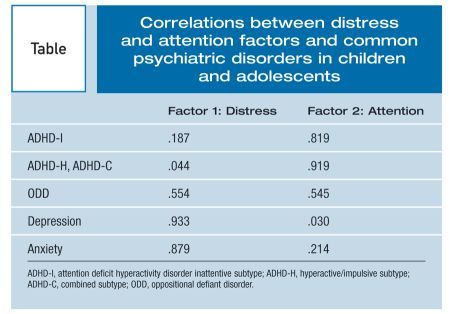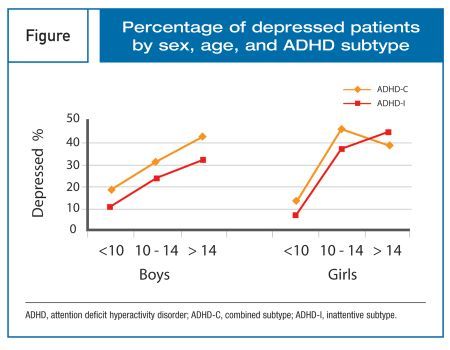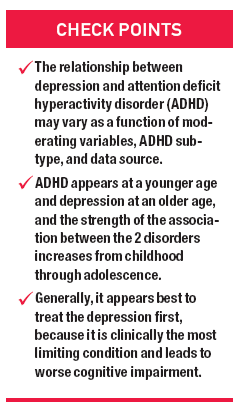Publication
Article
Psychiatric Times
Comorbid Depression and ADHD in Children and Adolescents
Author(s):
ADHD, the most common diagnosis in child psychiatry, appears to be more challenging to diagnose and treat when there is a comorbid depressive disorder.
Table

Figure

Attention deficit hyperactivity disorder (ADHD), the most common diagnosis in child psychiatry,

appears to be more challenging to diagnose and treat when there is a comorbid depressive disorder. In community samples, estimates of the prevalence of depression among patients with ADHD range from 13% to 27%, while clinical sample reports have run as high as 60%.1-3 Conversely, among children and adolescents with depression, various studies have reported widely varying rates of ADHD (from less than 5% to more than 50%); a recent study in very young children reported a rate of 42%.4,5 Nevertheless, ADHD and depressive disorders are often difficult to separate in clinical practice.
Depressed children often show more irritability and inattention than sadness, which may lead to a misdiagnosis of ADHD.6 Various algorithms and evidence-based treatment recommendations for comorbid ADHD and depression point in somewhat differing directions.3,7,8 In clinical practice, moderating factors that include age and sex as well as additional comorbid conditions add complexity.
In this article, we review key issues in the diagnosis, treatment, and outcome of comorbid ADHD and depression. We also highlight the importance of moderating variables and consider the validity of the distinction between internalizing and externalizing disorders. Our review of academic studies is complemented with new naturalistic findings from 3419 patients who were routinely assessed at baseline and 4-month follow-up in private practice.
Diagnostic controversies
Some conditions, such as thyroid disease, drug abuse, sleep disorders, learning disabilities, bipolar disorder, or attachment disorders may easily be misdiagnosed as ADHD if not screened for.6,9 Source bias in the diagnosis of ADHD remains a concern, parent and teacher ratings of schoolchildren are frequently inconsistent, and the validity of the most widely used instrument to diagnose ADHD-the Conners’ Rating Scale–Revised-has been seriously questioned.3,10 DSM-IV split the ADHD diagnosis presented in DSM-IIIR into inattentive and hyperactive/impulsive subtypes, and more recent research suggests other ways of subtyping ADHD11-13:
- With and without antisocial disorders.
- ADHD alone, ADHD with oppositional defiant disorder/conduct disorder (ODD/CD), ADHD with anxiety, and ADHD with ODD/CD and anxiety.
- Persistent versus nonpersistent ADHD.
Turning conventional wisdom on its head, research findings suggest that from a familial perspective, the assessment of ADHD may be more valid in adults than in children.14 Such findings can lead to polarized conclusions, including hypotheses that ADHD is genetically heterogeneous or that ADHD is not a disease but rather a group of symptoms that represents a common behavioral pathway for a range of emotional, psychological, and learning problems.3,13
Similarly, the diagnosis of depression in children is not without concerns. Historically, clinicians maintained that young children have difficulty naming affect and considered the diagnosis of mood disorders in children controversial.3,15 However, recent studies show more typical presentations of major depressive disorder (MDD) in children.5 In addition, there have been widely discrepant reports of the prevalence of depression among children with ADHD. The Multimodal Treatment Study of Children With ADHD (MTA) found mood disorders in only 4% of study participants, which is far lower than other studies and suggests that instruments used in that study may have been insensitive to depressive symptoms.16 Carefully controlled academic studies (mostly with boys) suggest that depression and ADHD are indeed distinct entities and not simply the product of overlapping symptoms, rater bias, or demoralization.9
Internalizing and externalizing disorders
Although ADHD is often considered an externalizing (overtly disruptive) disorder (as are ODD and CD) and depression is often considered a (nondisruptive) internalizing disorder (as is anxiety), the distinction between these 2 “super categories” is less clear than the names suggest. Externalizing disorders are related to a range of anxiety disorders. Findings from studies of patients with ADHD alone, with ADHD and dysthymia, and with dysthymia alone, indicate that the rates of externalizing symptoms or ODD are not significantly different.17,18 Other research shows that the association of depression with ODD/CD (one an internalizing and one an externalizing disorder) was almost as strong as that of depression and anxiety (2 internalizing disorders).4
Complementing these academic studies, we collected data from our clinic at Alabama Psychiatric Services (APS)-a private practice group with 11 offices, 38 psychiatrists, 45 nurses, and 34 therapists-that routinely integrates baseline and follow-up assessments into its inpatient, outpatient, and partial hospital services to adults, children, and adolescents. Our findings shed light on the relationship between the internalizing and externalizing disorders.19 We administered the Child and Adolescent Symptom Checklist (CAS) to parents of 3419 outpatients. The CAS is a fully automated, psychometrically sound rating scale (E. J. F., unpublished data, 2005), with 5 subscales that assess for ADHD:
- ADHD-inattentive (ADHD-I).
- ADHD-hyperactive/impulsive (ADHD-H).
- Generalized anxiety disorder.
- ODD.
- MDD.
The items on each subscale parallel the criteria for DSM-IV Category A of the corresponding diagnosis, and responses are on a 4-point scale of frequency. A factor analysis (principal components with varimax rotation) of CAS data reveals that 2 factors account for 77% of the variance.
The correlation between the factor and the underlying variables-factor loading-is shown in the Table. The 5 common childhood disorders may be represented by 2 factors that do not neatly follow the internal/external dichotomy. On factor 1 (a distress factor) anxiety and depression load heavily, and ODD loads moderately; on factor 2 (an attentional factor) ADHD-I and ADHD-H load heavily, and ODD loads moderately. In short, anger and acting out are components of both the distress and attentional factors. These findings align with clinical reality and indicate that irritability is often present in anxiety, depression, and ADHD.
Underlying factors
The relationship between depression and ADHD may vary as a function of moderating variables (sex, age, comorbid ODD), ADHD subtype, and data source (doctor, child, parent, teacher). For example, when we look at our entire sample, depression scores have a significantly higher correlation (P < .001) with ADHD-I than with ADHD-H. However, if we look at these same correlations within age groups (younger than 10 years, 10 to 14 years, older than 14 years) the highly significant differences in the correlations between depression and ADHD subtypes remain only for the youngest group (P < .0001) and there is merely a trend in the 2 older groups. Clinically, this highlights the importance of considering behaviors that are normed by age.
As another example of the power of moderating variables, our data showed that by controlling for ODD symptoms, a clear distinction emerged between depression and ADHD-H symptoms, while the relationship between depression and ADHD-I symptoms was significantly attenuated. This underscores the relative independence of depressive and ADHD syndromes when angry/irritable features are not present, suggested by the factor analysis in the Table. More generally, these results indicate that failing to sufficiently account for moderating variables and ADHD subtype may help explain why different investigators have reached different conclusions about whether the comorbidity between depression and ADHD is an epiphenomenon (accounted for by a third variable).4,20
The relationship between ADHD and depression symptoms can be refined even further by looking at the results by sex. On the CAS, the relationship between ADHD-I and depression scales was significantly stronger (P < .001) for boys than for girls (whether controlling for ODD or not). When controlling for ODD, the correlation for girls (r = .06) was clinically meaningless, while still statistically significant in our large sample. This finding suggests that when ODD features are absent, depression and ADHD-I are less closely related in girls, and thus more clearly distinguishable than in boys, in whom significant overlap remains and differential diagnosis may be more difficult.
Genetic research suggests that MDD with ADHD is an etiologically distinct subtype in females but not in males.21 Biederman and colleagues22 found that girls with ADHD were less likely than boys with ADHD to have MDD. This is an interesting finding because the prevalence of depression in the general population is higher in girls than in boys. These lines of evidence converge to indicate a clearer distinction between ADHD and depression in girls than in boys.
It remains unclear whether a clinically easier differential diagnosis in females produced a cleaner proband sample that led to a familial distinction or, conversely, whether a true etiological distinction leads to an easier differential diagnosis in girls than in boys. Clinically, it appears that a more rigorous assessment procedure is indicated whenever features of ODD are present with ADHD and depression, and that differential diagnosis may be more complicated in boys than in girls.
A strong relationship was found between ADHD and depression that was modified by age and comorbidity.23 This relationship was intensified when ODD/CD was present in older, but not younger, children. In general, ADHD appears at a younger age and depression at an older age, and, as expected, the strength of the association between the 2 disorders increases from childhood through adolescence.23,24
The importance of considering moderating variables and ADHD subtype is underscored by our findings (Figure), which show levels of depression as a function of sex, age, and ADHD subtype. The Figure shows that:
- Children and adolescents with ADHD-combined (ADHD-C) subtype generally have higher levels of depression than do youths with ADHD-I.
- Depression increases with age, and the rate of increase is greater in girls than in boys.
- Girls older than 10 years generally have higher levels of depression than boys, whereas the reverse appears true in children younger than 10 years.
This distinction underlies the finding that symptoms of depression are more highly correlated with inattentive symptoms than with hyperactive/impulsive symptoms, yet a diagnosis of ADHD-C in children is more likely to be comorbid with depression than a diagnosis of ADHD-I.
The main limitation of this study is the anomalous finding indicating that girls who are older than 14 years with ADHD-C have a slightly lower rate of depression than boys. Although the data are based on a sample of 920 patients with ADHD, by taking sex, age, and ADHD subtype into account, the results for the oldest girls may have limited reliability because of a rather small sample size.
These considerations help clarify some variable findings in the literature. For example, Biederman and colleagues22 found that boys with ADHD have higher rates of depression than girls, which, in girls older than age 10, is at variance with our findings. However, without understanding the mix of ADHD subtypes and ages of their study samples, it is not possible to directly compare their results with ours. Moreover, because their study was well resourced and in an academic center, it maximized specificity by requiring that 3 elements be satisfied for inclusion in the study:
- The clinical diagnosis.
- Confirmed by a telephone questionnaire with the mother.
- An in-person structured interview.
Because the criteria required multiple screens there may be questions of generalizability. For example, while the ADHD CAS scores for our sample were comparable to those of patients in the MTA, we found higher ODD scores in our sample than those found in the MTA participants.16,25 Perhaps the demanding protocol required for inclusion in the MTA selected a specialized subsample in which the families were more compliant with requests and the children had lower levels of ODD. If so, the degree to which the results of the MTA study could be generalized remains an open question.
Outcomes
Although comorbidity in ADHD generally leads to worse outcome, the impact of comorbid depression remains unclear. While Rostain9 highlights parental depression as a predictor of poor outcome in ADHD in his report on the MTA study, he does not list the child’s depression as a moderator of outcome.
Findings from our clinic show that patients with ADHD-C and comorbid depressive disorders have higher scores on both ADHD-I and ADHD-H scales than patients without comorbid depression. We also found that those without depressive comorbidity at baseline had a higher probability of being relatively free of ADHD symptoms at the 4-month follow-up (P < .05). However, patients without depressive comorbidity had lower ADHD scores to begin with, so they had less “distance” to recovery.
When we controlled for the degree of initial severity of ADHD, there was not a true difference in the degree of relative improvement between patients with and patients without depressive comorbidity at either the 4- or 8-month follow-up. By contrast, high scores on ODD predicted significantly less relative improvement at both the 4- and 8-month follow-ups (P < .05 for each). Moreover, patients with ADHD-C who initially scored high on both ODD and depression scales did worse at 4 months (P = .08) and significantly worse at 8 months (P < .05). These findings suggest that one reason that comorbidity has affected outcome differently in various studies in child and adolescent psychiatry is the failure to account for the full range of comorbid conditions.26-29 In this case, differing results emerge depending on whether ODD was considered.
Treatment issues
Generally, it appears best to treat the depression first, because it is clinically the most limiting condition and depressed patients show worse cognitive impairment.30 Unfortunately, most clinicians treat the ADHD first, usually at the insistence of the parents (and because it is possible to get a quick response). However, the depression may persist, and then one is forced to add to the treatment regimen.
Looking at individual medications may help fine-tune clinical decisions. Bupropion, although not a stimulant per se, may improve both ADHD symptoms and comorbid depression; it is as effective as methylphenidate.31,32 Findling33 reported that patients with ADHD and depression treated with fluoxetine or sertraline monotherapy were less depressed but showed no improvement in ADHD symptoms. Additional treatment with a psychostimulant was necessary to effectively address chronic ADHD. Conversely, the psychostimulants may not provide observable antidepressant effects, for which additional serotonin reuptake inhibitor treatment is required. In a Lilly-funded study of adolescents with ADHD and MDD, atomoxetine was an effective and safe treatment for ADHD but showed no efficacy in treating MDD.34 Consistent with these findings, the Texas Children’s Medication Algorithm Project protocol for treatment of comorbid ADHD and depression recommends treating the more severe disorder first, and, if the other disorder does not respond, treating it as well.8
In ADHD with bipolar depression, stimulants alone may destabilize bipolar disorder and should be avoided as monotherapy. Using a mood stabilizer, both bipolar and ADHD symptoms may improve, and the cautious addition of a stimulant may further benefit both conditions.35
On the other hand, Goodwin and Jamison36 hypothesize that “. . . many children with purported ADHD develop bipolar disorder in adulthood, raising the possibility that the ADHD-like presentation in childhood may have represented an early manifestation of bipolar illness.” They add, “We would urge caution in the diagnosis and treatment of adult ADHD, always giving preference to initially diagnosing and treating mood disorders until euthymia is achieved before making the ADHD diagnosis or seeking to treat it with stimulants.”
Conclusion
Comorbid depression in patients with ADHD suffers from an “attention deficit” by both researchers and clinicians, compared with other comorbidities (eg, ODD, anxiety). Based on academic studies and data from APS, depression in ADHD appears to be a distinct comorbidity, increasingly prevalent in children as they get older, with a higher rate of increase in girls than boys. By considering moderating variables, our data illustrate why findings in the field are often contradictory to those in academic studies.
Fully accounting for moderating variables is a formidable task; even with our large database, some study cohorts were underpowered. Externalizing and internalizing disorders, as traditionally conceptualized, appear to be overlapping rather than exclusive categories, with anger and acting out (ie, ODD features) cutting across both categories.
Depression alone does not seem to worsen the outcome of ADHD. Although this counterintuitive finding illustrates the controversial nature of the debate about diagnosis of and comorbidity in ADHD, our data also suggest that ODD may worsen the outcome of comorbid ADHD and depression. Should this suggestion be confirmed by further research, it would indicate the need for more aggressive intervention for this nonresponding subgroup.
Our findings highlight the necessity for a careful assessment of children and adolescents with ADHD and depression, with special attention to comorbid ODD as well as other moderating variables. Contradictory find-ings in treatment outcome may result from a failure to assess carefully.
Disclosures:
Dr Brunsvold is staff psychiatrist, Dr Oepen is assistant medical director, and Dr Akins is CEO and medical director of Alabama Psychiatric Services in Birmingham; Dr Federman is an instructor in the department of psychiatry at the Boston University School of Medicine. The authors report no conflicts of interest concerning the subject matter of this article.
References:
References
1. Kessler RC, Adler LA, Barkley R, et al. Patterns and predictors of attention-deficit/hyperactivity disorder persistence into adulthood: results from the national comorbidity survey replication. Biol Psychiatry. 2005;57:1442-1451.
2. Thakkar V, Adler L. Depression and ADHD: what you need to know. MedScape. http://www.medscape. com/viewarticle/549018_print. Accessed August 13, 2008.
3. Furman L. What is attention-deficit hyperactivity disorder (ADHD)? J Child Neurol. 2005;20:994-1002.
4. Angold A, Costello EJ, Erkanli A. Comorbidity. J Child Psychol Psychiatry. 1999;40:57-87.
5. Luby JL, Heffelfinger AK, Mrakotsky C, et al. The clinical picture of depression in preschool children. J Am Acad Child Adolesc Psychiatry. 2003;42:340-348.
6. Alston JF. The complex issue of attachment disorders. Psychiatric Times. October 1, 2007. http://www. psychiatrictimes.com/display/article/10168/54326. Accessed August 13, 2008.
7. Compton SN, March JS, Brent D, et al. Cognitive-behavioral psychotherapy for anxiety and depressive disorders in children and adolescents: an evidence-based medicine review. J Am Acad Child Adolesc Psychiatry. 2004;43:930-959.
8. Pliszka SR, Crismon ML, Hughes CW, et al. The Texas Children’s Medication Algorithm Project: revision of the algorithm for pharmacotherapy of attention-deficit/hyperactivity disorder. J Am Acad Child Adolesc Psychiatry. 2006;45:642-657.
9. Rostain AL. Treatment resistance in youths with ADHD and comorbid conditions. Psychiatric Times. October 1, 2007. http://www.psychiatrictimes.com/display/article/10168/54501. Accessed August 13, 2008.
10. Crystal DS, Ostrander R, Chen RS, August GJ. Multimethod assessment of psychopathology among DSM-IV subtypes of children with attention-deficit/hyperactivity disorder: self-, parent, and teacher reports. J Abnorm Child Psychol. 2001;29:189-205.
11. Faraone SV, Biederman J, Monuteaux MC. Attention-deficit disorder and conduct disorder in girls: evidence for a familial subtype. Biol Psychiatry. 2000; 48:21-29.
12. Jensen PS, Hinshaw SP, Kraemer HC, et al. ADHD comorbidity findings from the MTA study: comparing comorbid subgroups. J Am Acad Child Adolesc Psychiatry. 2001;40:147-158.
13. Faraone SV. Genetics of childhood disorders: XX. ADHD, Part 4: is ADHD genetically heterogeneous? J Am Acad Child Adolesc Psychiatry. 2000;39:1455-1457.
14. Faraone SV, Biederman J, Feighner JA, Monuteaux MC. Assessing symptoms of attention deficit hyperactivity disorder in children and adults: which is more valid? J Consult Clin Psychol. 2000;68:830-842.
15. Ryan ND. Diagnosing pediatric depression. Biol Psychiatry. 2001;49:1050-1054.
16. Swanson JM, Kraemer HC, Hinshaw SP, et al. Clinical relevance of the primary findings of the MTA: success rates based on severity of ADHD and ODD symptoms at the end of treatment. J Am Acad Child Adolesc Psychiatry. 2001;40:168-179.
17. Marmorstein NR. Relationships between anxiety and externalizing disorders in youth: the influences of age and gender. J Anxiety Disord. 2007;21:420-432.
18. Sanders M, Arduca Y, Karamitsios M, et al. Characteristics of internalizing and externalizing disorders in medication-naive, clinically referred children with attention deficit hyperactivity disorder, combined type and dysthymic disorder. Aust N Z J Psychiatry. 2005;39:359-365.
19. Oepen G, Federman EJ, Akins R. Measuring outcome in psychiatric private practice using outpatient self-reports. Psychiatric Times. June 1, 2006. http://www.psychiatrictimes.com/display/article/10168/51451. Accessed August 13, 2008.
20. Blackman GL, Ostrander R, Herman KC. Children with ADHD and depression: a multisource, multimethod assessment of clinical, social, and academic functioning. J Atten Disord. 2005;8:195-207.
21. Mick E, Biederman J, Santangelo S, Wypij D. The influence of gender in the familial association between ADHD and major depression. J Nerv Ment Dis. 2003;191:699-705.
22. Biederman J, Mick E, Faraone SV, et al. Influence of gender on attention deficit hyperactivity disorder in children referred to a psychiatric clinic. Am J Psychiatry. 2002;159:36-42.
23. Ostrander R, Crystal DS, August G. Attention deficit-hyperactivity disorder, depression, and self- and other-assessments of social competence: a developmental study. J Abnorm Child Psychol. 2006;34: 773-787.
24. Biederman J, Monuteaux MC, Mick E, et al. Young adult outcome of attention deficit hyperactivity disorder: a controlled 10-year follow-up study. Psychol Med. 2006;36:167-179.
25. MTA Cooperative Group. A 14-month randomized clinical trial of treatment strategies for attention-deficit/hyperactivity disorder. The MTA Cooperative Group. Multimodal Treatment Study of Children With ADHD. Arch Gen Psychiatry. 1999;56:1073-1086.
26. Doss AJ, Weisz JR. Syndrome co-occurrence and treatment outcomes in youth mental health clinics. J Consult Clin Psychol. 2006;74:416-425.
27. Jensen PS, Martin D, Cantwell DP. Comorbidity in ADHD: implications for research, practice, and DSM-V. J Am Acad Child Adolesc Psychiatry. 1997;36:1065-1079.
28. Jensen PS, Hinshaw SP, Kraemer HC, et al. Introduction: ADHD comorbidity and treatment outcomes in the MTA. J Am Acad Child Adolesc Psychiatry. 2001;40:134-136.
29. Kazdin AE, Whitley MK. Comorbidity, case complexity, and effects of evidence-based treatment for children referred for disruptive behavior. J Consult Clin Psychol. 2006;74:455-467.
30. Diler R, Daviss W, Birmaher B, et al. Differentiating major depressive disorder in youths with ADHD. Paper presented at: University of Pittsburgh Medical Center, Seventh Annual Research Day; June 2007.
31. Barrickman LL, Perry PJ, Allen AJ, et al. Bupropion versus methylphenidate in the treatment of attention-deficit hyperactivity disorder. J Am Acad Child Adolesc Psychiatry. 1995;34:649-657.
32. Solhkhah R, Wilens TE, Daly J, et al. Bupropion SR for the treatment of substance-abusing outpatient adolescents with attention-deficit/hyperactivity disorder and mood disorders. J Child Adolesc Psychopharmacol. 2005;15:777-786.
33. Findling RL. Open-label treatment of comorbid depression and attentional disorders with co-administration of serotonin reuptake inhibitors and psycho-stimulants in children, adolescents, and adults: a case series. J Child Adolesc Psychopharmacol. 1996;6: 165-175.
34. Bangs ME, Emslie GJ, Spencer TJ; Atomoxetine ADHD and Comorbid MDD Study Group, et al. Efficacy and safety of atomoxetine in adolescents with attention-deficit/hyperactivity disorder and major depression. J Child Adolesc Psychopharmacol. 2007;17: 407-420.
35. Scheffer RE. Concurrent ADHD and bipolar disorder. Curr Psychiatry Rep. 2007;9:415-419.
36. Goodwin FK, Jamison KR. Diagnosis. In: Goodwin FK, Jamison KR. Manic-Depressive Illness. 2nd ed. New York: Oxford University Press; 2007:89-118.
















